Detailed Analysis of Contract and Tort Law with Case Scenarios
VerifiedAdded on 2020/03/23
|9
|2232
|191
Report
AI Summary
This report examines the application of contract and tort law using two case scenarios. The first scenario analyzes the elements of a contract, including offer, acceptance, and consideration, and addresses the issue of mistakes, specifically unilateral mistakes. It also explores anticipatory breach of repudiation and its consequences. The second scenario focuses on tort law, specifically negligence, detailing the elements required to establish a claim, including duty of care, breach of duty, and causation. The report also addresses vicarious liability, where an employer can be held responsible for the actions of their employee. Finally, it discusses the types of damages that can be awarded, including special and general damages, providing a comprehensive overview of legal principles and their application in practical situations. The report includes a detailed bibliography with case citations and legal texts.
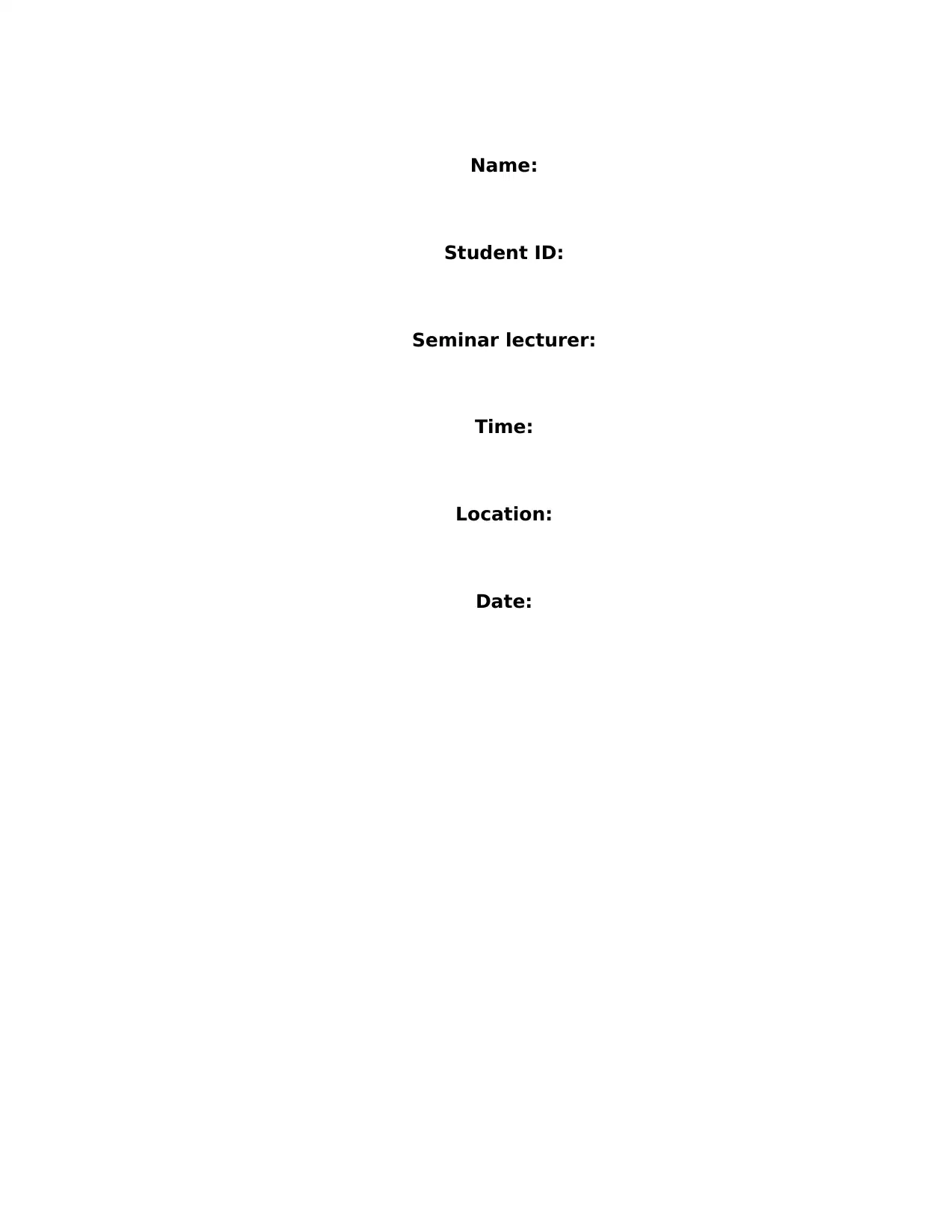
Name:
Student ID:
Seminar lecturer:
Time:
Location:
Date:
Student ID:
Seminar lecturer:
Time:
Location:
Date:
Paraphrase This Document
Need a fresh take? Get an instant paraphrase of this document with our AI Paraphraser
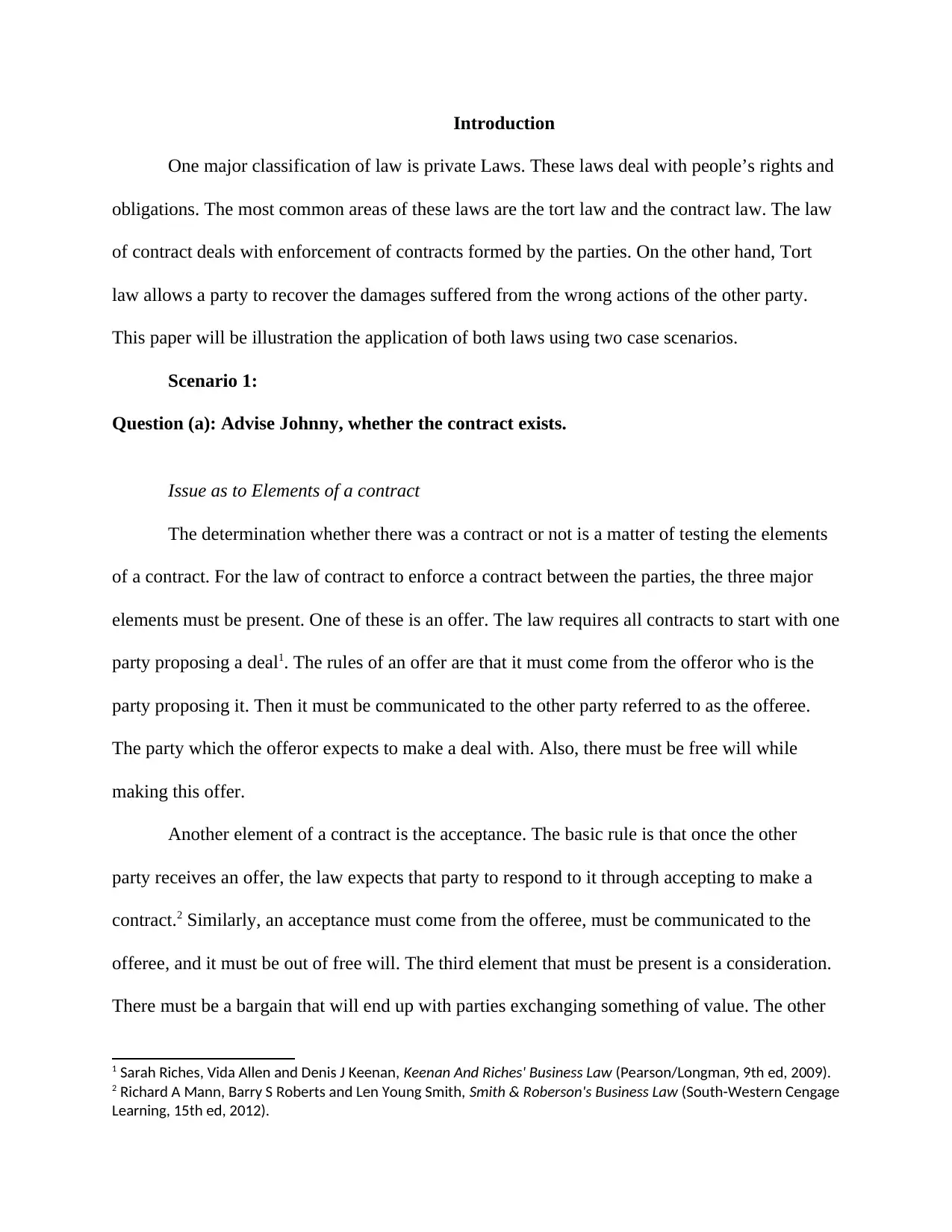
Introduction
One major classification of law is private Laws. These laws deal with people’s rights and
obligations. The most common areas of these laws are the tort law and the contract law. The law
of contract deals with enforcement of contracts formed by the parties. On the other hand, Tort
law allows a party to recover the damages suffered from the wrong actions of the other party.
This paper will be illustration the application of both laws using two case scenarios.
Scenario 1:
Question (a): Advise Johnny, whether the contract exists.
Issue as to Elements of a contract
The determination whether there was a contract or not is a matter of testing the elements
of a contract. For the law of contract to enforce a contract between the parties, the three major
elements must be present. One of these is an offer. The law requires all contracts to start with one
party proposing a deal1. The rules of an offer are that it must come from the offeror who is the
party proposing it. Then it must be communicated to the other party referred to as the offeree.
The party which the offeror expects to make a deal with. Also, there must be free will while
making this offer.
Another element of a contract is the acceptance. The basic rule is that once the other
party receives an offer, the law expects that party to respond to it through accepting to make a
contract.2 Similarly, an acceptance must come from the offeree, must be communicated to the
offeree, and it must be out of free will. The third element that must be present is a consideration.
There must be a bargain that will end up with parties exchanging something of value. The other
1 Sarah Riches, Vida Allen and Denis J Keenan, Keenan And Riches' Business Law (Pearson/Longman, 9th ed, 2009).
2 Richard A Mann, Barry S Roberts and Len Young Smith, Smith & Roberson's Business Law (South-Western Cengage
Learning, 15th ed, 2012).
One major classification of law is private Laws. These laws deal with people’s rights and
obligations. The most common areas of these laws are the tort law and the contract law. The law
of contract deals with enforcement of contracts formed by the parties. On the other hand, Tort
law allows a party to recover the damages suffered from the wrong actions of the other party.
This paper will be illustration the application of both laws using two case scenarios.
Scenario 1:
Question (a): Advise Johnny, whether the contract exists.
Issue as to Elements of a contract
The determination whether there was a contract or not is a matter of testing the elements
of a contract. For the law of contract to enforce a contract between the parties, the three major
elements must be present. One of these is an offer. The law requires all contracts to start with one
party proposing a deal1. The rules of an offer are that it must come from the offeror who is the
party proposing it. Then it must be communicated to the other party referred to as the offeree.
The party which the offeror expects to make a deal with. Also, there must be free will while
making this offer.
Another element of a contract is the acceptance. The basic rule is that once the other
party receives an offer, the law expects that party to respond to it through accepting to make a
contract.2 Similarly, an acceptance must come from the offeree, must be communicated to the
offeree, and it must be out of free will. The third element that must be present is a consideration.
There must be a bargain that will end up with parties exchanging something of value. The other
1 Sarah Riches, Vida Allen and Denis J Keenan, Keenan And Riches' Business Law (Pearson/Longman, 9th ed, 2009).
2 Richard A Mann, Barry S Roberts and Len Young Smith, Smith & Roberson's Business Law (South-Western Cengage
Learning, 15th ed, 2012).
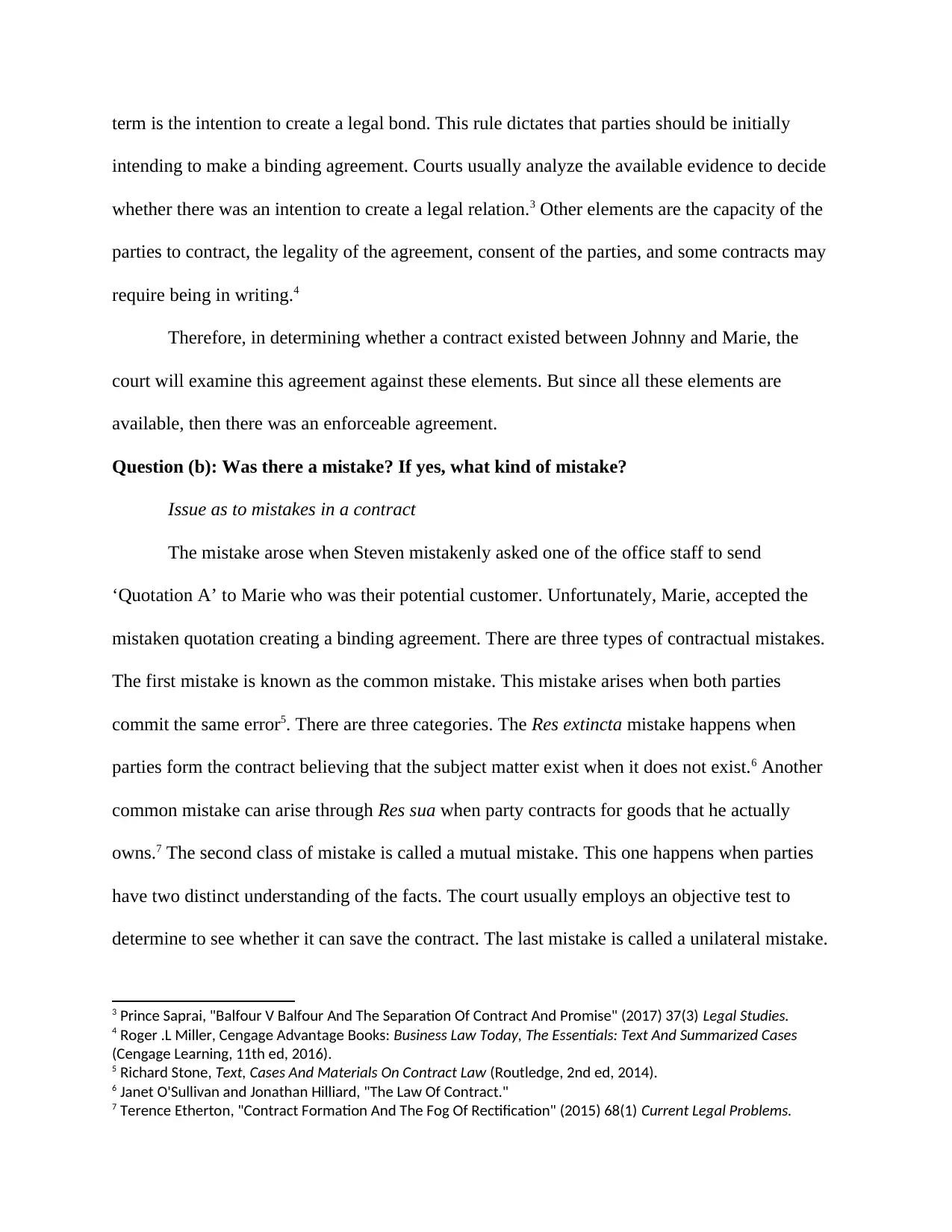
term is the intention to create a legal bond. This rule dictates that parties should be initially
intending to make a binding agreement. Courts usually analyze the available evidence to decide
whether there was an intention to create a legal relation.3 Other elements are the capacity of the
parties to contract, the legality of the agreement, consent of the parties, and some contracts may
require being in writing.4
Therefore, in determining whether a contract existed between Johnny and Marie, the
court will examine this agreement against these elements. But since all these elements are
available, then there was an enforceable agreement.
Question (b): Was there a mistake? If yes, what kind of mistake?
Issue as to mistakes in a contract
The mistake arose when Steven mistakenly asked one of the office staff to send
‘Quotation A’ to Marie who was their potential customer. Unfortunately, Marie, accepted the
mistaken quotation creating a binding agreement. There are three types of contractual mistakes.
The first mistake is known as the common mistake. This mistake arises when both parties
commit the same error5. There are three categories. The Res extincta mistake happens when
parties form the contract believing that the subject matter exist when it does not exist.6 Another
common mistake can arise through Res sua when party contracts for goods that he actually
owns.7 The second class of mistake is called a mutual mistake. This one happens when parties
have two distinct understanding of the facts. The court usually employs an objective test to
determine to see whether it can save the contract. The last mistake is called a unilateral mistake.
3 Prince Saprai, "Balfour V Balfour And The Separation Of Contract And Promise" (2017) 37(3) Legal Studies.
4 Roger .L Miller, Cengage Advantage Books: Business Law Today, The Essentials: Text And Summarized Cases
(Cengage Learning, 11th ed, 2016).
5 Richard Stone, Text, Cases And Materials On Contract Law (Routledge, 2nd ed, 2014).
6 Janet O'Sullivan and Jonathan Hilliard, "The Law Of Contract."
7 Terence Etherton, "Contract Formation And The Fog Of Rectification" (2015) 68(1) Current Legal Problems.
intending to make a binding agreement. Courts usually analyze the available evidence to decide
whether there was an intention to create a legal relation.3 Other elements are the capacity of the
parties to contract, the legality of the agreement, consent of the parties, and some contracts may
require being in writing.4
Therefore, in determining whether a contract existed between Johnny and Marie, the
court will examine this agreement against these elements. But since all these elements are
available, then there was an enforceable agreement.
Question (b): Was there a mistake? If yes, what kind of mistake?
Issue as to mistakes in a contract
The mistake arose when Steven mistakenly asked one of the office staff to send
‘Quotation A’ to Marie who was their potential customer. Unfortunately, Marie, accepted the
mistaken quotation creating a binding agreement. There are three types of contractual mistakes.
The first mistake is known as the common mistake. This mistake arises when both parties
commit the same error5. There are three categories. The Res extincta mistake happens when
parties form the contract believing that the subject matter exist when it does not exist.6 Another
common mistake can arise through Res sua when party contracts for goods that he actually
owns.7 The second class of mistake is called a mutual mistake. This one happens when parties
have two distinct understanding of the facts. The court usually employs an objective test to
determine to see whether it can save the contract. The last mistake is called a unilateral mistake.
3 Prince Saprai, "Balfour V Balfour And The Separation Of Contract And Promise" (2017) 37(3) Legal Studies.
4 Roger .L Miller, Cengage Advantage Books: Business Law Today, The Essentials: Text And Summarized Cases
(Cengage Learning, 11th ed, 2016).
5 Richard Stone, Text, Cases And Materials On Contract Law (Routledge, 2nd ed, 2014).
6 Janet O'Sullivan and Jonathan Hilliard, "The Law Of Contract."
7 Terence Etherton, "Contract Formation And The Fog Of Rectification" (2015) 68(1) Current Legal Problems.
⊘ This is a preview!⊘
Do you want full access?
Subscribe today to unlock all pages.

Trusted by 1+ million students worldwide
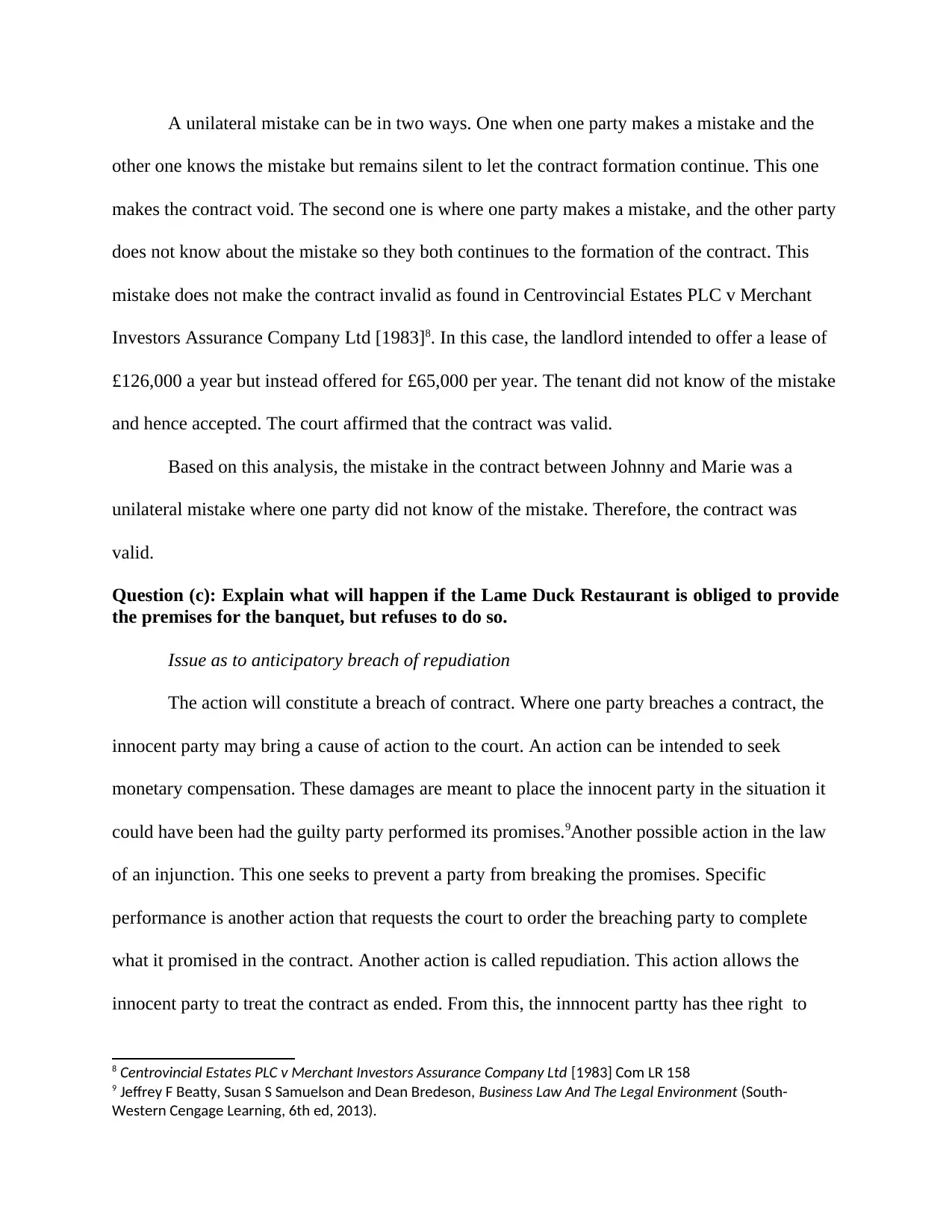
A unilateral mistake can be in two ways. One when one party makes a mistake and the
other one knows the mistake but remains silent to let the contract formation continue. This one
makes the contract void. The second one is where one party makes a mistake, and the other party
does not know about the mistake so they both continues to the formation of the contract. This
mistake does not make the contract invalid as found in Centrovincial Estates PLC v Merchant
Investors Assurance Company Ltd [1983]8. In this case, the landlord intended to offer a lease of
£126,000 a year but instead offered for £65,000 per year. The tenant did not know of the mistake
and hence accepted. The court affirmed that the contract was valid.
Based on this analysis, the mistake in the contract between Johnny and Marie was a
unilateral mistake where one party did not know of the mistake. Therefore, the contract was
valid.
Question (c): Explain what will happen if the Lame Duck Restaurant is obliged to provide
the premises for the banquet, but refuses to do so.
Issue as to anticipatory breach of repudiation
The action will constitute a breach of contract. Where one party breaches a contract, the
innocent party may bring a cause of action to the court. An action can be intended to seek
monetary compensation. These damages are meant to place the innocent party in the situation it
could have been had the guilty party performed its promises.9Another possible action in the law
of an injunction. This one seeks to prevent a party from breaking the promises. Specific
performance is another action that requests the court to order the breaching party to complete
what it promised in the contract. Another action is called repudiation. This action allows the
innocent party to treat the contract as ended. From this, the innnocent partty has thee right to
8 Centrovincial Estates PLC v Merchant Investors Assurance Company Ltd [1983] Com LR 158
9 Jeffrey F Beatty, Susan S Samuelson and Dean Bredeson, Business Law And The Legal Environment (South-
Western Cengage Learning, 6th ed, 2013).
other one knows the mistake but remains silent to let the contract formation continue. This one
makes the contract void. The second one is where one party makes a mistake, and the other party
does not know about the mistake so they both continues to the formation of the contract. This
mistake does not make the contract invalid as found in Centrovincial Estates PLC v Merchant
Investors Assurance Company Ltd [1983]8. In this case, the landlord intended to offer a lease of
£126,000 a year but instead offered for £65,000 per year. The tenant did not know of the mistake
and hence accepted. The court affirmed that the contract was valid.
Based on this analysis, the mistake in the contract between Johnny and Marie was a
unilateral mistake where one party did not know of the mistake. Therefore, the contract was
valid.
Question (c): Explain what will happen if the Lame Duck Restaurant is obliged to provide
the premises for the banquet, but refuses to do so.
Issue as to anticipatory breach of repudiation
The action will constitute a breach of contract. Where one party breaches a contract, the
innocent party may bring a cause of action to the court. An action can be intended to seek
monetary compensation. These damages are meant to place the innocent party in the situation it
could have been had the guilty party performed its promises.9Another possible action in the law
of an injunction. This one seeks to prevent a party from breaking the promises. Specific
performance is another action that requests the court to order the breaching party to complete
what it promised in the contract. Another action is called repudiation. This action allows the
innocent party to treat the contract as ended. From this, the innnocent partty has thee right to
8 Centrovincial Estates PLC v Merchant Investors Assurance Company Ltd [1983] Com LR 158
9 Jeffrey F Beatty, Susan S Samuelson and Dean Bredeson, Business Law And The Legal Environment (South-
Western Cengage Learning, 6th ed, 2013).
Paraphrase This Document
Need a fresh take? Get an instant paraphrase of this document with our AI Paraphraser
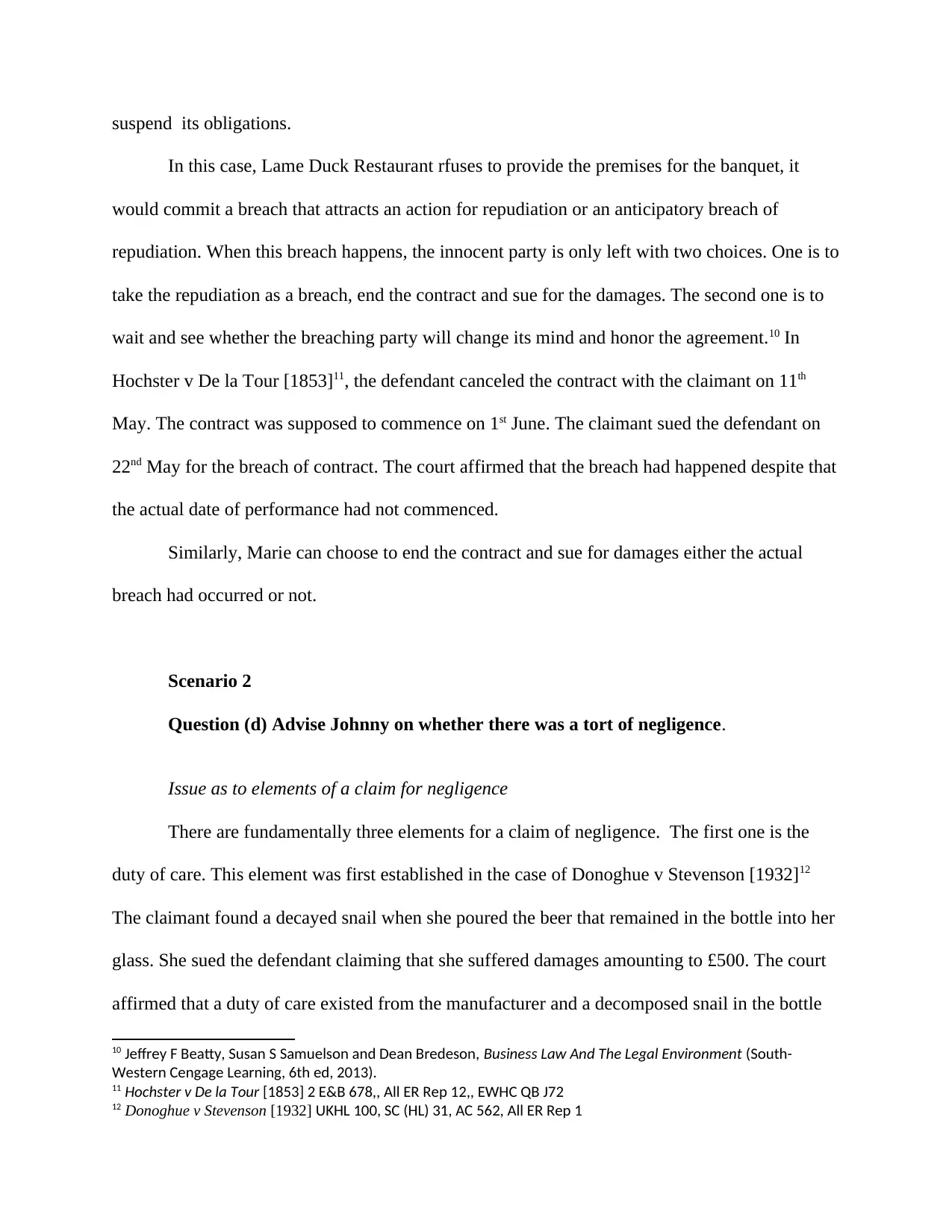
suspend its obligations.
In this case, Lame Duck Restaurant rfuses to provide the premises for the banquet, it
would commit a breach that attracts an action for repudiation or an anticipatory breach of
repudiation. When this breach happens, the innocent party is only left with two choices. One is to
take the repudiation as a breach, end the contract and sue for the damages. The second one is to
wait and see whether the breaching party will change its mind and honor the agreement.10 In
Hochster v De la Tour [1853]11, the defendant canceled the contract with the claimant on 11th
May. The contract was supposed to commence on 1st June. The claimant sued the defendant on
22nd May for the breach of contract. The court affirmed that the breach had happened despite that
the actual date of performance had not commenced.
Similarly, Marie can choose to end the contract and sue for damages either the actual
breach had occurred or not.
Scenario 2
Question (d) Advise Johnny on whether there was a tort of negligence.
Issue as to elements of a claim for negligence
There are fundamentally three elements for a claim of negligence. The first one is the
duty of care. This element was first established in the case of Donoghue v Stevenson [1932]12
The claimant found a decayed snail when she poured the beer that remained in the bottle into her
glass. She sued the defendant claiming that she suffered damages amounting to £500. The court
affirmed that a duty of care existed from the manufacturer and a decomposed snail in the bottle
10 Jeffrey F Beatty, Susan S Samuelson and Dean Bredeson, Business Law And The Legal Environment (South-
Western Cengage Learning, 6th ed, 2013).
11 Hochster v De la Tour [1853] 2 E&B 678,, All ER Rep 12,, EWHC QB J72
12 Donoghue v Stevenson [1932] UKHL 100, SC (HL) 31, AC 562, All ER Rep 1
In this case, Lame Duck Restaurant rfuses to provide the premises for the banquet, it
would commit a breach that attracts an action for repudiation or an anticipatory breach of
repudiation. When this breach happens, the innocent party is only left with two choices. One is to
take the repudiation as a breach, end the contract and sue for the damages. The second one is to
wait and see whether the breaching party will change its mind and honor the agreement.10 In
Hochster v De la Tour [1853]11, the defendant canceled the contract with the claimant on 11th
May. The contract was supposed to commence on 1st June. The claimant sued the defendant on
22nd May for the breach of contract. The court affirmed that the breach had happened despite that
the actual date of performance had not commenced.
Similarly, Marie can choose to end the contract and sue for damages either the actual
breach had occurred or not.
Scenario 2
Question (d) Advise Johnny on whether there was a tort of negligence.
Issue as to elements of a claim for negligence
There are fundamentally three elements for a claim of negligence. The first one is the
duty of care. This element was first established in the case of Donoghue v Stevenson [1932]12
The claimant found a decayed snail when she poured the beer that remained in the bottle into her
glass. She sued the defendant claiming that she suffered damages amounting to £500. The court
affirmed that a duty of care existed from the manufacturer and a decomposed snail in the bottle
10 Jeffrey F Beatty, Susan S Samuelson and Dean Bredeson, Business Law And The Legal Environment (South-
Western Cengage Learning, 6th ed, 2013).
11 Hochster v De la Tour [1853] 2 E&B 678,, All ER Rep 12,, EWHC QB J72
12 Donoghue v Stevenson [1932] UKHL 100, SC (HL) 31, AC 562, All ER Rep 1
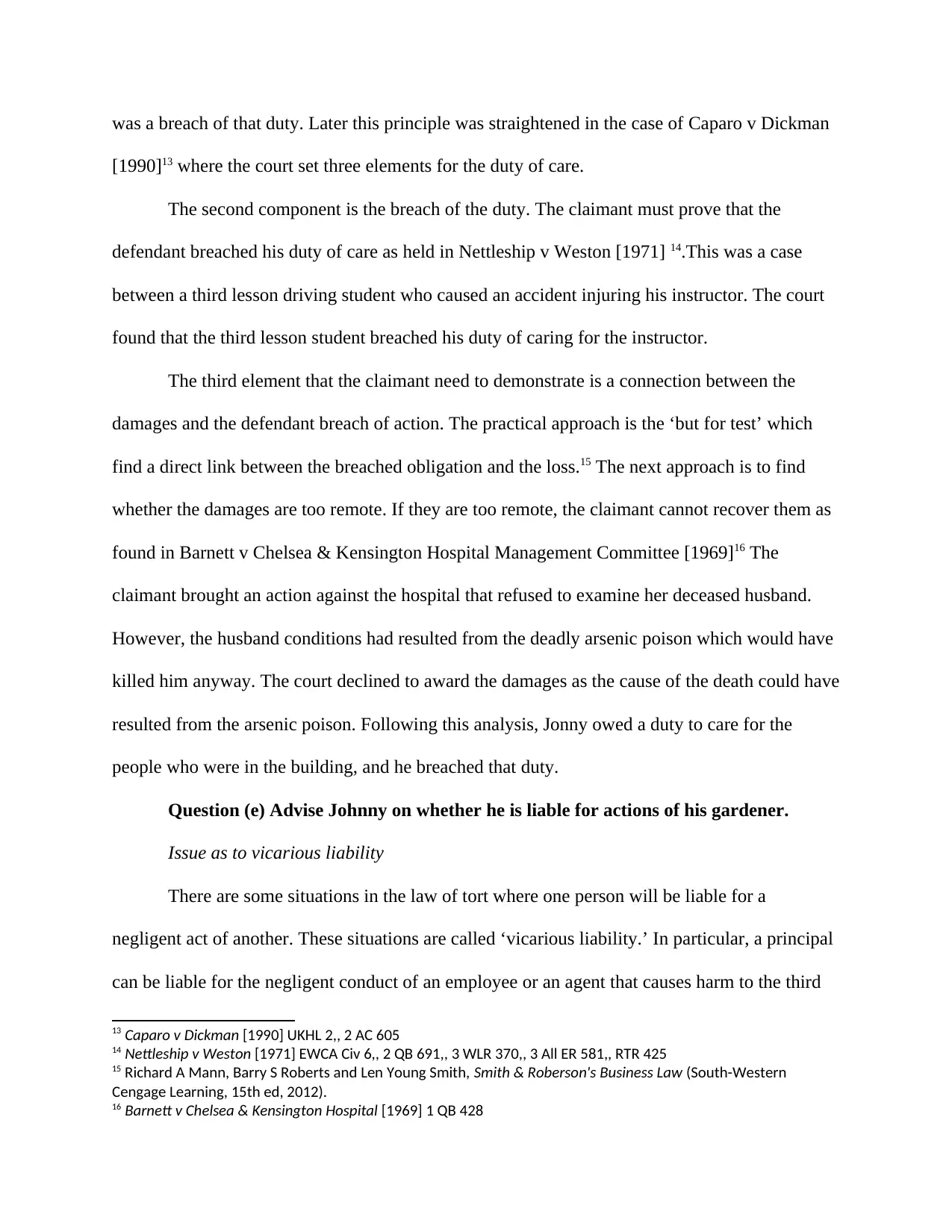
was a breach of that duty. Later this principle was straightened in the case of Caparo v Dickman
[1990]13 where the court set three elements for the duty of care.
The second component is the breach of the duty. The claimant must prove that the
defendant breached his duty of care as held in Nettleship v Weston [1971] 14.This was a case
between a third lesson driving student who caused an accident injuring his instructor. The court
found that the third lesson student breached his duty of caring for the instructor.
The third element that the claimant need to demonstrate is a connection between the
damages and the defendant breach of action. The practical approach is the ‘but for test’ which
find a direct link between the breached obligation and the loss.15 The next approach is to find
whether the damages are too remote. If they are too remote, the claimant cannot recover them as
found in Barnett v Chelsea & Kensington Hospital Management Committee [1969]16 The
claimant brought an action against the hospital that refused to examine her deceased husband.
However, the husband conditions had resulted from the deadly arsenic poison which would have
killed him anyway. The court declined to award the damages as the cause of the death could have
resulted from the arsenic poison. Following this analysis, Jonny owed a duty to care for the
people who were in the building, and he breached that duty.
Question (e) Advise Johnny on whether he is liable for actions of his gardener.
Issue as to vicarious liability
There are some situations in the law of tort where one person will be liable for a
negligent act of another. These situations are called ‘vicarious liability.’ In particular, a principal
can be liable for the negligent conduct of an employee or an agent that causes harm to the third
13 Caparo v Dickman [1990] UKHL 2,, 2 AC 605
14 Nettleship v Weston [1971] EWCA Civ 6,, 2 QB 691,, 3 WLR 370,, 3 All ER 581,, RTR 425
15 Richard A Mann, Barry S Roberts and Len Young Smith, Smith & Roberson's Business Law (South-Western
Cengage Learning, 15th ed, 2012).
16 Barnett v Chelsea & Kensington Hospital [1969] 1 QB 428
[1990]13 where the court set three elements for the duty of care.
The second component is the breach of the duty. The claimant must prove that the
defendant breached his duty of care as held in Nettleship v Weston [1971] 14.This was a case
between a third lesson driving student who caused an accident injuring his instructor. The court
found that the third lesson student breached his duty of caring for the instructor.
The third element that the claimant need to demonstrate is a connection between the
damages and the defendant breach of action. The practical approach is the ‘but for test’ which
find a direct link between the breached obligation and the loss.15 The next approach is to find
whether the damages are too remote. If they are too remote, the claimant cannot recover them as
found in Barnett v Chelsea & Kensington Hospital Management Committee [1969]16 The
claimant brought an action against the hospital that refused to examine her deceased husband.
However, the husband conditions had resulted from the deadly arsenic poison which would have
killed him anyway. The court declined to award the damages as the cause of the death could have
resulted from the arsenic poison. Following this analysis, Jonny owed a duty to care for the
people who were in the building, and he breached that duty.
Question (e) Advise Johnny on whether he is liable for actions of his gardener.
Issue as to vicarious liability
There are some situations in the law of tort where one person will be liable for a
negligent act of another. These situations are called ‘vicarious liability.’ In particular, a principal
can be liable for the negligent conduct of an employee or an agent that causes harm to the third
13 Caparo v Dickman [1990] UKHL 2,, 2 AC 605
14 Nettleship v Weston [1971] EWCA Civ 6,, 2 QB 691,, 3 WLR 370,, 3 All ER 581,, RTR 425
15 Richard A Mann, Barry S Roberts and Len Young Smith, Smith & Roberson's Business Law (South-Western
Cengage Learning, 15th ed, 2012).
16 Barnett v Chelsea & Kensington Hospital [1969] 1 QB 428
⊘ This is a preview!⊘
Do you want full access?
Subscribe today to unlock all pages.

Trusted by 1+ million students worldwide
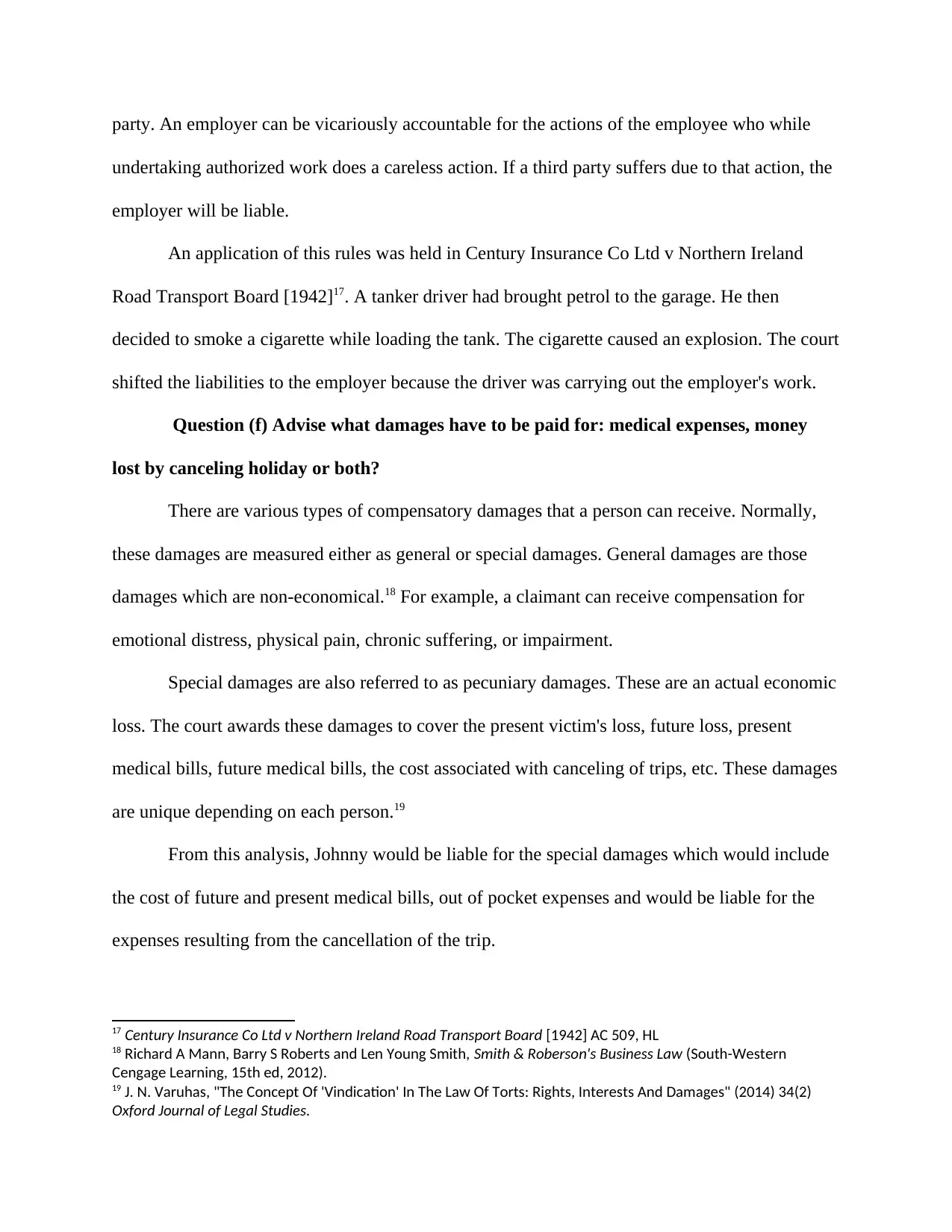
party. An employer can be vicariously accountable for the actions of the employee who while
undertaking authorized work does a careless action. If a third party suffers due to that action, the
employer will be liable.
An application of this rules was held in Century Insurance Co Ltd v Northern Ireland
Road Transport Board [1942]17. A tanker driver had brought petrol to the garage. He then
decided to smoke a cigarette while loading the tank. The cigarette caused an explosion. The court
shifted the liabilities to the employer because the driver was carrying out the employer's work.
Question (f) Advise what damages have to be paid for: medical expenses, money
lost by canceling holiday or both?
There are various types of compensatory damages that a person can receive. Normally,
these damages are measured either as general or special damages. General damages are those
damages which are non-economical.18 For example, a claimant can receive compensation for
emotional distress, physical pain, chronic suffering, or impairment.
Special damages are also referred to as pecuniary damages. These are an actual economic
loss. The court awards these damages to cover the present victim's loss, future loss, present
medical bills, future medical bills, the cost associated with canceling of trips, etc. These damages
are unique depending on each person.19
From this analysis, Johnny would be liable for the special damages which would include
the cost of future and present medical bills, out of pocket expenses and would be liable for the
expenses resulting from the cancellation of the trip.
17 Century Insurance Co Ltd v Northern Ireland Road Transport Board [1942] AC 509, HL
18 Richard A Mann, Barry S Roberts and Len Young Smith, Smith & Roberson's Business Law (South-Western
Cengage Learning, 15th ed, 2012).
19 J. N. Varuhas, "The Concept Of 'Vindication' In The Law Of Torts: Rights, Interests And Damages" (2014) 34(2)
Oxford Journal of Legal Studies.
undertaking authorized work does a careless action. If a third party suffers due to that action, the
employer will be liable.
An application of this rules was held in Century Insurance Co Ltd v Northern Ireland
Road Transport Board [1942]17. A tanker driver had brought petrol to the garage. He then
decided to smoke a cigarette while loading the tank. The cigarette caused an explosion. The court
shifted the liabilities to the employer because the driver was carrying out the employer's work.
Question (f) Advise what damages have to be paid for: medical expenses, money
lost by canceling holiday or both?
There are various types of compensatory damages that a person can receive. Normally,
these damages are measured either as general or special damages. General damages are those
damages which are non-economical.18 For example, a claimant can receive compensation for
emotional distress, physical pain, chronic suffering, or impairment.
Special damages are also referred to as pecuniary damages. These are an actual economic
loss. The court awards these damages to cover the present victim's loss, future loss, present
medical bills, future medical bills, the cost associated with canceling of trips, etc. These damages
are unique depending on each person.19
From this analysis, Johnny would be liable for the special damages which would include
the cost of future and present medical bills, out of pocket expenses and would be liable for the
expenses resulting from the cancellation of the trip.
17 Century Insurance Co Ltd v Northern Ireland Road Transport Board [1942] AC 509, HL
18 Richard A Mann, Barry S Roberts and Len Young Smith, Smith & Roberson's Business Law (South-Western
Cengage Learning, 15th ed, 2012).
19 J. N. Varuhas, "The Concept Of 'Vindication' In The Law Of Torts: Rights, Interests And Damages" (2014) 34(2)
Oxford Journal of Legal Studies.
Paraphrase This Document
Need a fresh take? Get an instant paraphrase of this document with our AI Paraphraser
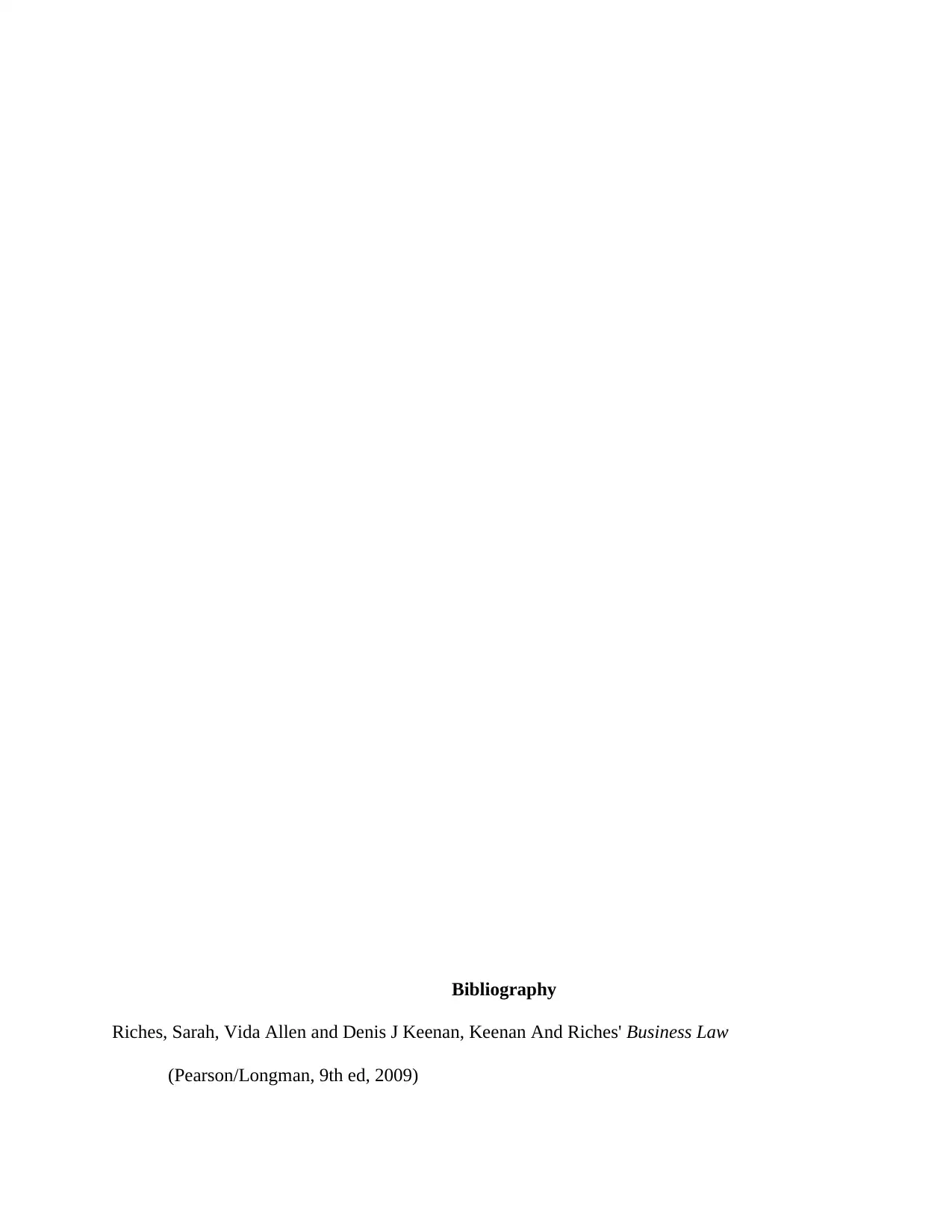
Bibliography
Riches, Sarah, Vida Allen and Denis J Keenan, Keenan And Riches' Business Law
(Pearson/Longman, 9th ed, 2009)
Riches, Sarah, Vida Allen and Denis J Keenan, Keenan And Riches' Business Law
(Pearson/Longman, 9th ed, 2009)
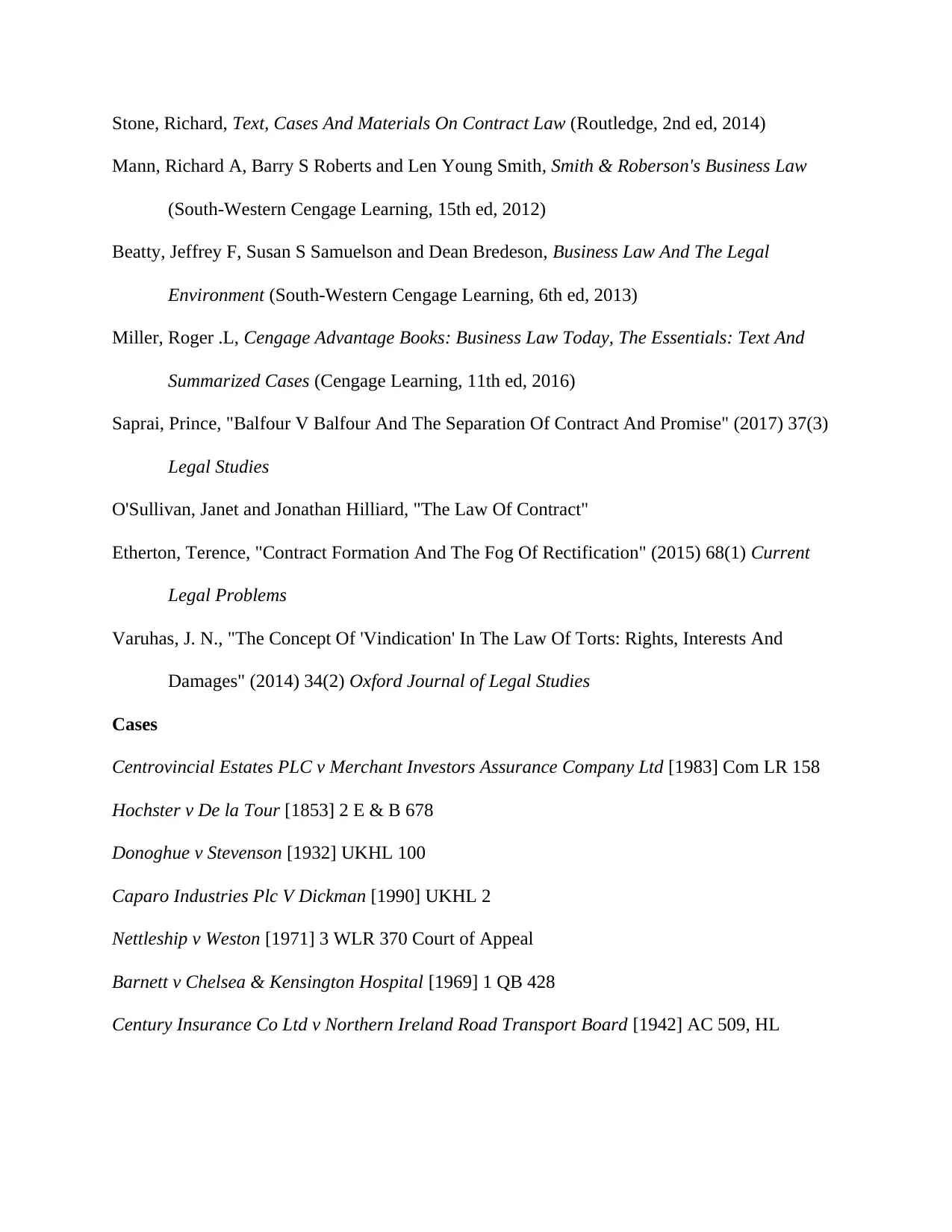
Stone, Richard, Text, Cases And Materials On Contract Law (Routledge, 2nd ed, 2014)
Mann, Richard A, Barry S Roberts and Len Young Smith, Smith & Roberson's Business Law
(South-Western Cengage Learning, 15th ed, 2012)
Beatty, Jeffrey F, Susan S Samuelson and Dean Bredeson, Business Law And The Legal
Environment (South-Western Cengage Learning, 6th ed, 2013)
Miller, Roger .L, Cengage Advantage Books: Business Law Today, The Essentials: Text And
Summarized Cases (Cengage Learning, 11th ed, 2016)
Saprai, Prince, "Balfour V Balfour And The Separation Of Contract And Promise" (2017) 37(3)
Legal Studies
O'Sullivan, Janet and Jonathan Hilliard, "The Law Of Contract"
Etherton, Terence, "Contract Formation And The Fog Of Rectification" (2015) 68(1) Current
Legal Problems
Varuhas, J. N., "The Concept Of 'Vindication' In The Law Of Torts: Rights, Interests And
Damages" (2014) 34(2) Oxford Journal of Legal Studies
Cases
Centrovincial Estates PLC v Merchant Investors Assurance Company Ltd [1983] Com LR 158
Hochster v De la Tour [1853] 2 E & B 678
Donoghue v Stevenson [1932] UKHL 100
Caparo Industries Plc V Dickman [1990] UKHL 2
Nettleship v Weston [1971] 3 WLR 370 Court of Appeal
Barnett v Chelsea & Kensington Hospital [1969] 1 QB 428
Century Insurance Co Ltd v Northern Ireland Road Transport Board [1942] AC 509, HL
Mann, Richard A, Barry S Roberts and Len Young Smith, Smith & Roberson's Business Law
(South-Western Cengage Learning, 15th ed, 2012)
Beatty, Jeffrey F, Susan S Samuelson and Dean Bredeson, Business Law And The Legal
Environment (South-Western Cengage Learning, 6th ed, 2013)
Miller, Roger .L, Cengage Advantage Books: Business Law Today, The Essentials: Text And
Summarized Cases (Cengage Learning, 11th ed, 2016)
Saprai, Prince, "Balfour V Balfour And The Separation Of Contract And Promise" (2017) 37(3)
Legal Studies
O'Sullivan, Janet and Jonathan Hilliard, "The Law Of Contract"
Etherton, Terence, "Contract Formation And The Fog Of Rectification" (2015) 68(1) Current
Legal Problems
Varuhas, J. N., "The Concept Of 'Vindication' In The Law Of Torts: Rights, Interests And
Damages" (2014) 34(2) Oxford Journal of Legal Studies
Cases
Centrovincial Estates PLC v Merchant Investors Assurance Company Ltd [1983] Com LR 158
Hochster v De la Tour [1853] 2 E & B 678
Donoghue v Stevenson [1932] UKHL 100
Caparo Industries Plc V Dickman [1990] UKHL 2
Nettleship v Weston [1971] 3 WLR 370 Court of Appeal
Barnett v Chelsea & Kensington Hospital [1969] 1 QB 428
Century Insurance Co Ltd v Northern Ireland Road Transport Board [1942] AC 509, HL
⊘ This is a preview!⊘
Do you want full access?
Subscribe today to unlock all pages.

Trusted by 1+ million students worldwide
1 out of 9
Related Documents
Your All-in-One AI-Powered Toolkit for Academic Success.
+13062052269
info@desklib.com
Available 24*7 on WhatsApp / Email
![[object Object]](/_next/static/media/star-bottom.7253800d.svg)
Unlock your academic potential
Copyright © 2020–2025 A2Z Services. All Rights Reserved. Developed and managed by ZUCOL.





